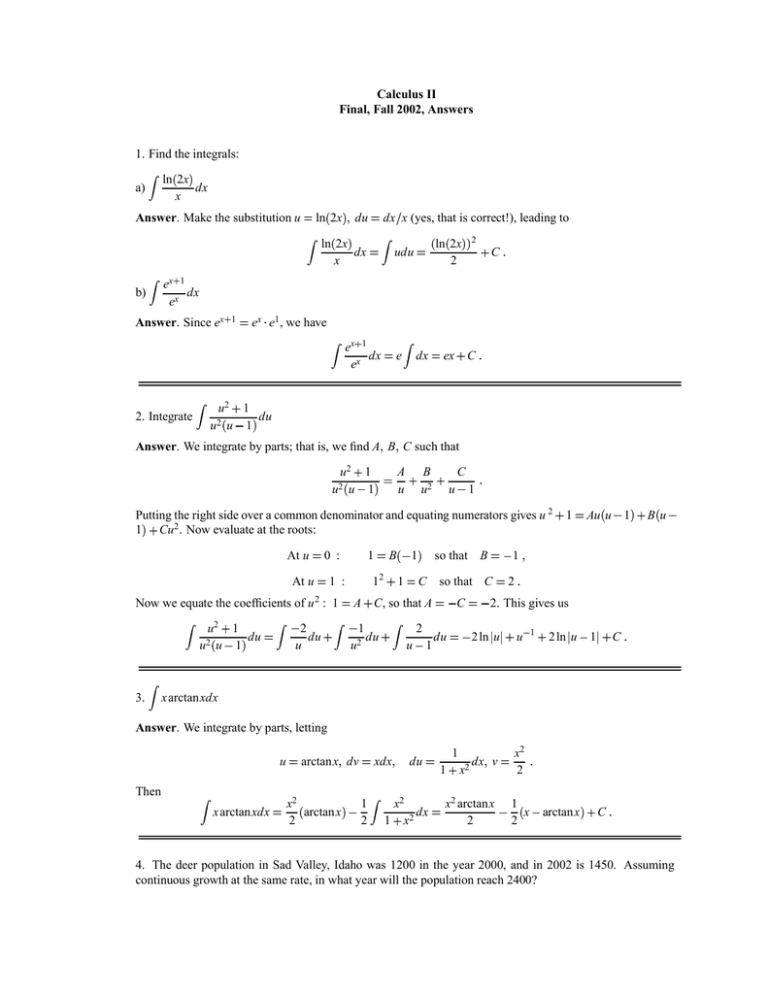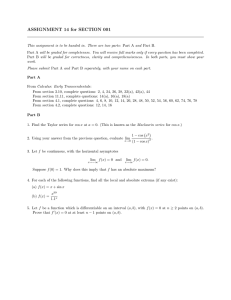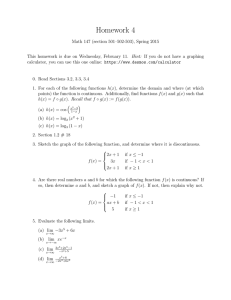Document 11740980
advertisement

Calculus II Final, Fall 2002, Answers 1. Find the integrals: ln 2x dx x a) Answer. Make the substitution u ln 2x du dx x (yes, that is correct!), leading to ln 2x dx x udu ln 2x 2 2 C ex 1 dx ex b) Answer. Since ex 1 ex e1 , we have ex 1 dx e ex 2. Integrate dx ex C u2 1 du u 1 u2 Answer. We integrate by parts; that is, we find A B C such that u2 1 u2 u 1 A B C 2 u u u 1 Putting the right side over a common denominator and equating numerators gives u 2 1 Au u 1 B u 1 Cu2 . Now evaluate at the roots: At u 0 : 1 B 1 12 At u 1 : 1 C so that B 1 so that C 2 Now we equate the coefficients of u 2 : 1 A C, so that A C 2. This gives us u2 1 du u2 u 1 3. 2 u du 1 u2 du 2 du 2 ln u u u 1 1 2 ln u 1 C x arctanxdx Answer. We integrate by parts, letting u arctanx dv xdx Then x arctanxdx x2 1 arctan x 2 2 du x2 dx 1 x2 1 1 dx v x2 x2 2 x2 arctanx 1 C x arctanx 2 2 4. The deer population in Sad Valley, Idaho was 1200 in the year 2000, and in 2002 is 1450. Assuming continuous growth at the same rate, in what year will the population reach 2400? Answer. The growth equation is P P0 ert , where t is the number of years after 2000. We are given P0 1200 P 2 1450 and are asked; for what t do we have P t 2400? First, find r: From 1450 1200e 2r , we get 1 1450 r ln 0946 2 1200 Now, solve 1200e 0946t 2400, or t ln 2 0946 7 326 years. 5. Find the limit. Show your work. sin π x l H π cos π x π lim x 4 16 2x 8 ex 1 l H ex 1 x l H b) Answer. lim lim lim 2 x 0 x 0 4x x 0 4 2x a) Answer. lim x 4 x2 ex x3 l H ∞ ex c) Answer. limx 3x2 l H ∞ ex limx limx 1 4 6x l H ∞ ex 6 ∞ ex limx 0 6. Do the integrals converge? If so, evaluate: ∞ a) Answer. 1 ∞ b) Answer. 0 2θ e dθ dt 1 t A lim A ∞ 1 2θ e dθ A 0 dt diverges since lim e A ∞ 1 2θ A 1 2 2 1 t ln 1 ∞ as A A ∞. 7. Here are some series and sequences. Write the letter C if there is convergence, and the letter D if not. a lim n ∞ n! 2n ! 2n n ∞ n2 b lim c 3n2 2n 1 n ∞ 4n3 1 d Σ∞ n n ln n 2 1 n3 1 h Σ∞ n lim n f Σ∞ n 1 n n 1 n 3 2 g Σ∞ n 1 n! 2n ! e Σ∞ n 1 2 n n 1 1 1 2n 1 2n 2 Answer. a) C since the denominator is greater than n 1 times the numerator, b) D by l’Hôpital’s rule, c) C since the degree of the denominator is one more than the degree of the numerator, d) C by the ratio test, e) D since the degree of the denominator is only one more than the degree of the numerator, f) D since the general term does not converge to zero. g) C since the degree of the denominator is more than one more than the degree of the numerator, h) C by comparison with the series ∑ 1 n2 . 8. Find the focus of the parabola given by the equation y 2 8x 2y 17 0. Answer. Complete the square; y2 2y 1 8x 16 or y 1 2 8 x 2 The vertex is at 2 1 and the parabola opens to the right. Since 4p 8, p 2, and the focus is 2 units right of the vertex, so is at 4 1 . 9. Find the area of the region enclosed by the curve given in polar coordinates by r 2 cos θ . Answer. This is the circle of radius 1 centered at the point (1,0) so has area π . If you did not recognize the curve, you integrated, but only from 0 to π , since that is all you need to traverse the whole boundary. Thus Area π 0 1 2 r dθ 2 1 2 π 0 10. a) Find the general solution of the differential equation y Answer. The auxiliary equation, r 2 4r π 2 cos θ 2 d θ 0 1 4y cos 2θ d θ π 5y 0. 5 0 has the roots r 2 ! i. Thus the general solution is yh e2x A cos x B sinx b) Solve the initial value problem: y 4y 5y 5 y 0 " 0 y 0 " 0 Answer. A particular solution is the constant function y p 1. Thus the general solution is y y p yh 1 e2x A cos x B sinx . We solve for A and B from the initial conditions: 0 1 and the solution is y 1 e 2x # cos x A 0 2A 2sin x . B so A 1 B 2







